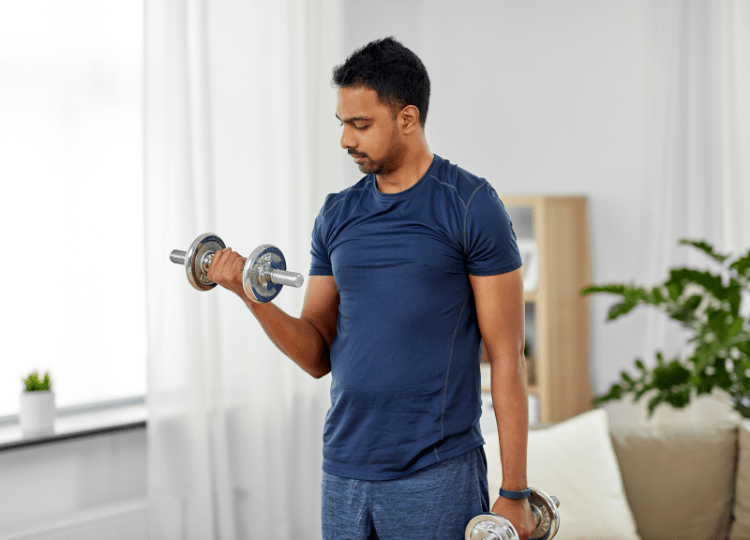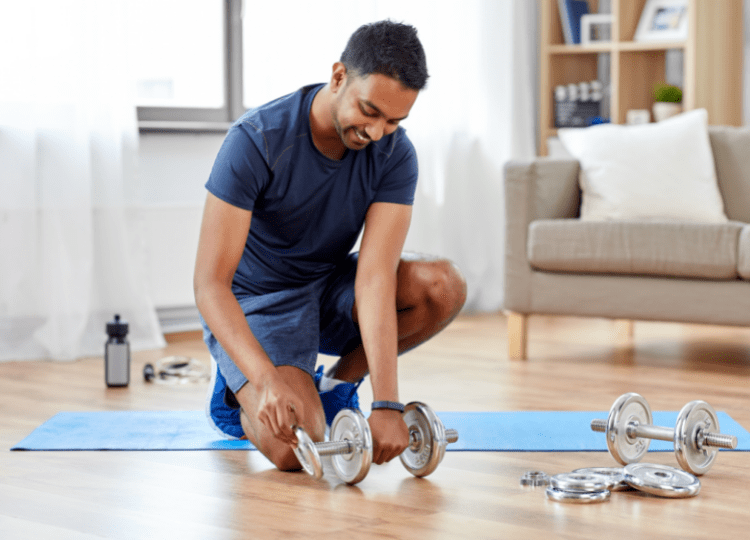If you’re looking for positive bicep gains… negative curls may just be the answer you’ve been searching for.
The term “negative curl” or “negative rep” relates to eccentric training. This is the process of building muscle during the “lowering” phase of an exercise, as opposed to the lifting phase of an exercise (which would be “concentric training”).
Although most workouts tend to focus more on concentric training (the lifting part), eccentric training (the lowering part) is actually fundamental to how our bodies build muscle through hypertrophy.
By emphasizing the lowering part of the movement, it keeps the muscle engaged for longer, recruits more muscle fibres and allows you to lift heavier weights… meaning this subtle change in approach can lead to some substantial benefits.
In this handy guide, we outline everything you need to know about negative bicep curls and how to start using them effectively in your next workout.
What Are Eccentric Negative Bicep Curls?
Negative bicep curls involve lowering the weight slower compared to a regular bicep curl. This can be done with any type of resistance or weight, such as dumbbells, barbell, kettlebell or bands.
It can also be applied to different types of bicep curls, from hammer curls, to preacher curls… the concept remains the same.
Where things get really interesting with negative reps is the amount of weight that can be lowered. On average, people can usually lower more weight than they can lift… up to 40% in fact. This means you can put your biceps under 40% more resistance during your workout!
The result?
Increased strength… increased muscle mass… increased definition.

There are two ways to approach negative or “eccentric” training.
You can either focus on lifting the same weight but lowering the weights much slower. This will push the muscles into overdrive and you’ll benefit from the increased muscle engagement during the exercise.
The other way is to get a workout buddy to help you lift heavier weights up, so you can slowly lower more weight than you could lift. This requires someone to help ensure you can get the increased weight to the starting position safely, but brings with it increased benefits around having more weight to lower.
Don’t try and swing more weight up to the starting position as this could lead to injury.
How to do Negative Bicep Curls
- Stand with your feet shoulder width apart, and hold a dumbbell in each hand by your side.
- Keep your chest up and head straight.
- Inhale and lift the dumbbells up by bending at the elbow.
- As you exhale, slowly lower the dumbbells back to the starting position over 4-8 seconds (the slower the movement, the harder it is).
- Repeat for repetitions.
Coach’s Tip – If you’re looking to really push yourself, try doing negative bicep curls with a training partner. This will allow them to help you lift the weight during the concentric movement so you can lower even more weight than normal. This will help grow and strengthen your biceps and forearms further.
Muscles Worked During Negative Bicep Curls
Negative bicep curls primarily target the biceps as well as the forearms and shoulders. Depending on the type of curl you are doing, there may be more emphasis on either the inner or outer head of the bicep.
Eccentric Negative Bicep Curl Workout
Below is a simple bicep workout that focuses on negatives. Give it a go and see how you get on. This could be paired with a similar tricep workout to ensure you build a balanced physique. Start with lighter weights to get used to the slower movement, before increasing the weight.
This negative bicep workout includes 3 sets of 3 exercises.
1. Negative Dumbbell Curls
- 8-12 reps
- 3 sets
Grab a pair of dumbbells and hold them in each hand by your side. Lift them up, bending at the elbow before slowly lowering them back down over a duration of 4 seconds. Repeat this for 8-12 reps. Repeat for a total of 3 sets.
2. Negative Barbell Curls
- 8-12 reps
- 3 sets
Add plates to a barbell and hold the bar using an underhand grip. Lift the bar upwards, bending at the elbow. Slowly lower the bar back down over a duration of 4 seconds. Repeat this for 8-12 reps. Repeat for a total of 3 sets.
If you have a workout buddy, you could try adding more weight to the bar and have them help you lift the bar up, before slowly lowering it.
3. Negative EZ Bar Curls
- 8-12 reps
- 3 sets
Similar to the barbell curls, add plates to an EZ bar and decide on your preferred grip (an EZ bar can be held to put more emphasis on the inner or outer head of the bicep). Lift the bar upwards, bending at the elbow. Slowly lower the bar back down over a duration of 4 seconds. Repeat this for 8-12 reps. Repeat for a total of 3 sets.
Benefits of Negative Bicep Curls
Use Your Preferred Equipment
One of our favourite benefits of negative bicep curls (or any sort of negative training) is that you can apply the theory to most types of equipment. This means regardless of whether you prefer doing bicep curls with dumbbells or barbells, you can still benefit from negative curls.
Curl Variations
You can also use different hand grips and curl variations with negative reps. Whether you like incline hammer curls, or keeping your palms facing forward, the choice is yours.
Beginner Friendly
As far as movments go, doing negative reps isn’t too complicated… in fact, most people should find them pretty easy to get started with.
The gains all stem from doing the movements nice and slow, so you naturally avoid falling into traps of trying to use your momentum to shift heavy weight (which many beginners do with regular bicep curls).
Just stand straight and keep those elbows stable… and feel the burn!
Increased Muscle Mass and Growth
The muscle fibres are stretched during the eccentric part of the movement and this is where a lot of the muscle tissue microdamage occurs… which leads to the development and growth of stronger, thicker fibres. Simply put, this means increased muscle mass.
As mentioned previously, you can usually lower up to 40% more weight than you can lift. This means that with negative bicep curls, you can really put your arms under a lot more resistance, which will lead to increase muscle growth.
Get Creative With Light Weights
If the weights you are using feel too light (i.e. you can do 15+ repetitions with ease), doing negative repetitions is a great way to enhance the workout and ensure you keep pushing your muscles.
If you go reeeeeeal slow… even a light dumbbell can be enough to get your biceps working overdrive.
A set made up of slow (negative) reps will be much harder than a set made up for normal (positive) reps, so it’s also a great way to instantly increase the difficulty of a workout.

Safer
When we focus exclusively on putting all our energy into lifting a heavy weight, the drawback can be that said weight comes crashing back with force. By definition, slow negative reps require you to control this returning movement.
The result? You being in control of the weight… as opposed to the weight being in control of you.
This is likely to reduce the risk of injury during the exercise.
Increased Arm Strength
If you want to improve your overall strength, negative bicep curls are certainly worth a consideration, as you can put your biceps under increased resistance.
This is useful to support other exercises, such as squats or deadlift, whereby your arms are needed to support other muscle groups.
Having stronger biceps in these situations is definitely not a bad thing.
Similarly, stronger arms helps support functional fitness and makes everyday activities easier.
Less Fatigue
An interesting study from the Journal of Strength and Conditioning Research called “Comparison of concentric and eccentric bench press repetitions to failure”, illustrated that eccentric training resulted in lowered levels of fatigue during a workout.
This is useful for those looking for an efficient workout, whereby they could include negative reps with other exercises, without feeling so exhausted after doing heavy bicep curls that they need to call it a day.
Things to Consider
Eccentric training, such as negative curls, can deliver some amazing results… but it does push your muscles to the limit, especially if you’re overloading them with increased weight.
This means recovery is vital.
You’ll likely experience the DOMS after the first time you do it. We’ve got a whole article about tips for help avoiding the DOMS during intense workouts.
Also, remember to give your triceps some attention too, which helps to avoid muscular imbalances.
Bottom Line
Although the words like “eccentric training” or “negative reps” may sound like they’re reserved only for professional athletes or bodybuilders, the truth is, they reflect a simple approach to exercise that anyone can benefit from.
Negative bicep curls are a great way to engage your biceps so you can see improvements in your overall fitness.
Most Personal Trainers would recommend a varied fitness routine, whereby you include different ways to train your muscles. This means doing both eccentric and concentric movements.
